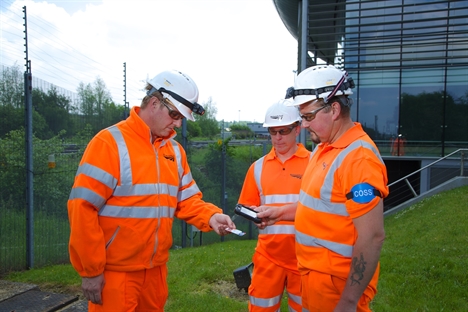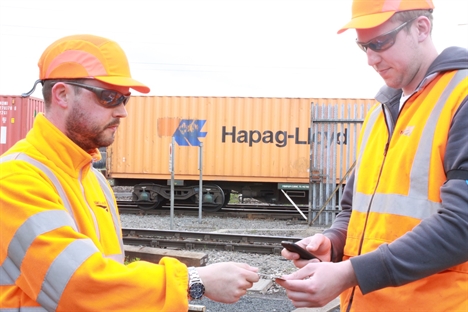01.08.15
More than 30,000 new Sentinel users in the next few years
Source: RTM Aug/Sep 15
With the Sentinel scheme about to enter a new phase, RTM looks back at its success up to now with Network Rail programme manager for the scheme, Andrew Bilous.
Every month, 1,000 people get denied access to the live railway infrastructure thanks to the Sentinel smartcard scheme, because they do not have a valid PTS (personal track safety competence), or else because they lack valid and in-date medical certification or a drugs and alcohol test.
Obviously the old paper-based Sentinel system, launched in 1999, would have caught some of these people – but the fact is, that data could never be collected before.
 “We didn’t know what we didn’t know”, is how Andrew Bilous, programme manager at Network Rail (pictured left), puts it. “We just don’t know what went on before, because it wasn’t measured, it wasn’t collected, and we didn’t have the ability to measure it. But now we do: all these things are automatically recorded on a detailed and thorough database.
“We didn’t know what we didn’t know”, is how Andrew Bilous, programme manager at Network Rail (pictured left), puts it. “We just don’t know what went on before, because it wasn’t measured, it wasn’t collected, and we didn’t have the ability to measure it. But now we do: all these things are automatically recorded on a detailed and thorough database.
“Fundamentally, this has got to be making our infrastructure a safer place to work,” he added.”
The relaunch
Sentinel was relaunched in digitised, smartcard form in 2013, enabling a near-real-time check against a central database using mobile phones, a web check or a hotline.
One of the reasons the old version was phased out was because of the costly bureaucracy of constantly printing new cards, though even with the new smartcards, several thousand are being produced every month due to churn in the industry.
The expansion of the scheme, and the fact that Transport for London (TfL) is now using Sentinel too for its supply chain, mean that in just a few years’ time there will be 30,000 or even 40,000 more Sentinel users. There are currently estimated to be perhaps 100,000 users, about 20,000 of whom are Network Rail’s own staff, and the rest from the supply chain.
For TfL, Bilous said, “it made inherent sense for them not to reinvent their own database when a lot of Sentinel will meet their needs”. He added: “They will develop that in future years to be designed specifically to meet their competency and access needs. But right now they are using it in a developmental format.”
Sentinel has replaced TfL’s old LUCAS cards, which are no longer being printed as of April 2015 (though each card remains valid until the date shown on it).
Sentinel is also now being used to record the Industry Common Induction (ICI), the briefing on health and safety issues common across the rail industry, regardless of the precise role or worksite.
Bilous said: “It makes inherent sense. Rather than repeating the ICI time and time again, if we can find a safe and reliable way to record which workers have gone through the ICI, then they don’t have to repeat it. There’s going to be an efficiency saving in people not repeating training. They’ll just get site-by-site specific top-ups and information to make sure they’re safe and fit to work.
“I’m quite excited by that. People are starting to see Sentinel as being about more than just access and the traditional way it’s been used.”
There is a separate add-on endorsement, called ICI-LU, necessary to access London Underground infrastructure.
NSARE
In 2013, the National Skills Academy for Railway Engineering (NSARE) launched SkillsID, which provides a centralised location where people’s entire history of competency and training records can be stored, eliminating manual records-keeping and duplication.
It got warm backing from the supply chain, Network Rail and TfL on its launch, and there were hopes that it could be closely integrated with Sentinel. That seems to have stalled somewhat, and Bilous said there were questions about the “most suitable platform for recording that type of information”.
He added: “That we as an industry need long-term skills forecasting is not in doubt, and that we as an industry need to use NSARE’s skills to develop that capability is not in doubt. What remains to be answered technically is what’s the best platform for delivering that capability.”
He said there is a technical evaluation going on about the “best tool” to use in the future.
Challenges
There are two main barriers to Sentinel being a complete success: one cultural, and the other technological.

On the cultural side, Bilous admitted: “You can’t change the behaviour of 100,000 people by writing a few glossy brochures and giving a few briefings. So there have been some real challenges in getting people to use the new smartcard and technology.
“There are pockets across the country where both the technology and the willingness to use it have been embraced, and is in full swing; and there are pockets where that has not been the case. The beauty of the new technology is that I know where it’s not being used, and where it is being used.”
The Sentinel team are refreshing their marketing and communications to get the right message across, to improve understanding of the scheme and the way people use the card.
Its messaging to frontline workers includes ‘Why do I care?’ statements, like: “I am a skilled worker and I don’t want to work with cowboys”, “I care about myself and others”, and “I am part of a great team”, with workers who are “proud, safe and united” knowing they must authenticate with Sentinel before every shift.
On the technical side, Bilous admits the current app is “not intuitive”, and indeed a new version has been designed and will be rolled out soon.
“The new version is far more intuitive, much more ergonomic in terms of its layout and design, and follows the natural flow of checking competence, making sure that the COSS (controller of site safety) or SWL (safe work leader) follows it in a much more straightforward and easy-to-follow sequence.
“Out there, late at night in the cold and wet, you’ve got people trying to use technology and it’s not always easy. If the instructions on the screen are open to interpretation, people are going to press some of the wrong buttons. That’s why we’ve got to get our communications right, and our processes right.”
That redesign has been done by technical supplier Mitie, which produced the original off-the-shelf package on which Sentinel is based. It was customised and developed for Network Rail’s specific needs. “They’ve been a good partner,” Bilous said.
Planning & Delivering Safe Work
SWLs have come out of Network Rail’s parallel Planning & Delivering Safe Work (PDSW) programme to change safety and site management and ensure the right person is in charge, from an appropriate tier of the supply chain, and who is incentivised to prioritise safety. Bilous said the two programmes have worked well together, and that there was an element of ‘Sentinel-isation’ built into the PDSW initiative. “Sentinel will be a key tool for SWLs. They’ll be using it to confirm that their workforce are safe, in-date and fit to work,” he said.
The lone worker capability is also now live, and is being used by about 1,400 people every month. “That’s growing every month as people become more aware of its capabilities,” Bilous said. That system was covered in detail in the August/September 2014 edition of RTM, with descriptions of both the Push4Help and Heartbeat services. A video explaining more is available on the RTM website.
The next stage
The refreshed app and new communications push – the “authentication campaign”, as Bilous calls it – are both being rolled out ahead of and alongside the next evolution of Sentinel, known as Site Access, which comes in from the beginning of 2016.

Site Access means swiping out after work (on top of the current need to swipe in to authenticate) to improve fatigue management and to deter so-called double-shifting.
Network Rail says there is a “moral and regulatory obligation to protect our workforce from the dangers of fatigue”. But it is assuring workers that it is not about spying on them to monitor how long they have been at work. Site Access also allows workers to record safety events, site inductions and use of competence, “removing a lot of on-site paperwork”, as Network Rail puts it.
From September 2015, Bilous’ team is running a series of ‘Sentinel Summits’ with key influencers within Network Rail and the supply chain, engaging as many as 800 people about the coming changes. “It’s not the only part of our campaign, but it is the start of it,” Bilous said. “We’re targeting people of influence within organisations, and those with the ability and willingness to pass that information on.”
The early versions of the new app design will also be previewed at the Summits. From October, testing of Site Access begins, to be complete by December ahead of the January 2016 scheduled deployment date.
Once Site Access and the new app go live, the other alternative methods of authentication will stay live. Right from the beginning, there was a push to ensure it wasn’t limited to one device, but is ‘agnostic’. “There are multiple platforms to authenticate and I think that’s important,” Bilous said. “There are loads of scenarios where one system won’t work in certain parts of the country in certain ways. You’ve got to have other methods so you can have back-up ways to do it. Some of the lengths I’ve seen people go to in order to get authentication right have been quite admirable, and it’s those areas of best practice I’m trying to share during the Sentinel Summits and communicate as follow-on messages across the industry.”
Discussing the specific benefits of Site Access, Bilous said: “Fatigue comes up in a very large percentage of accident investigations. It’s not fair to say that this will let us manage fatigue for the first time, but we can do so for the first time consistently across the whole industry. We will have the technical platform to be able to do that with this next phase, and to deter double-shifting. There are really exciting benefits.”
There will be a detailed look at the upcoming Site Access changes in the next edition of RTM.